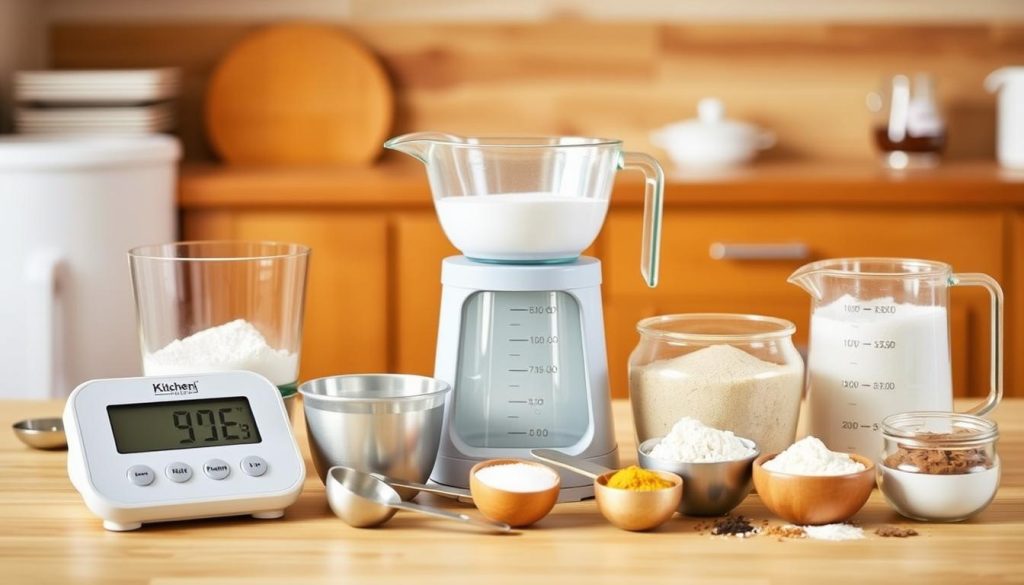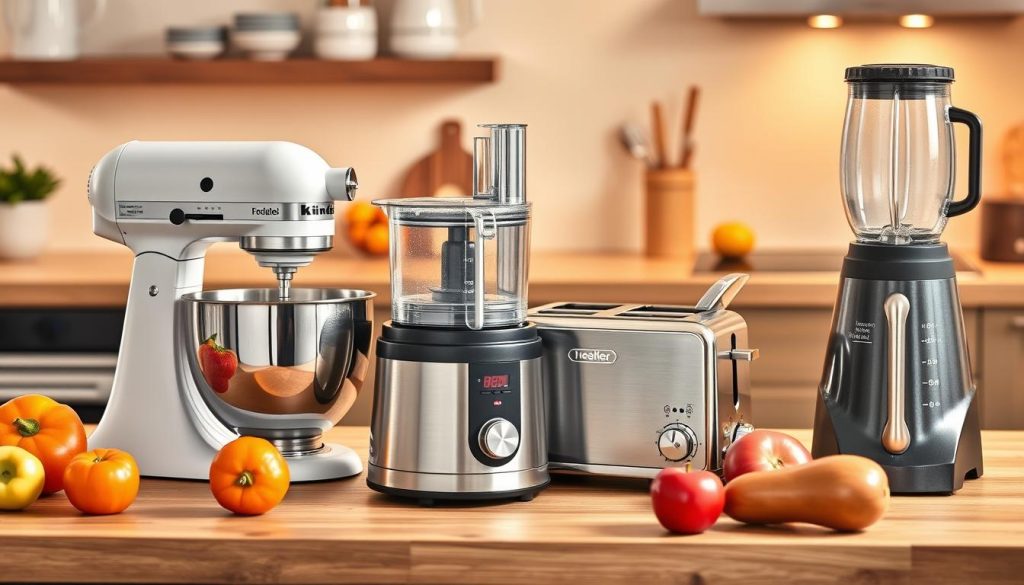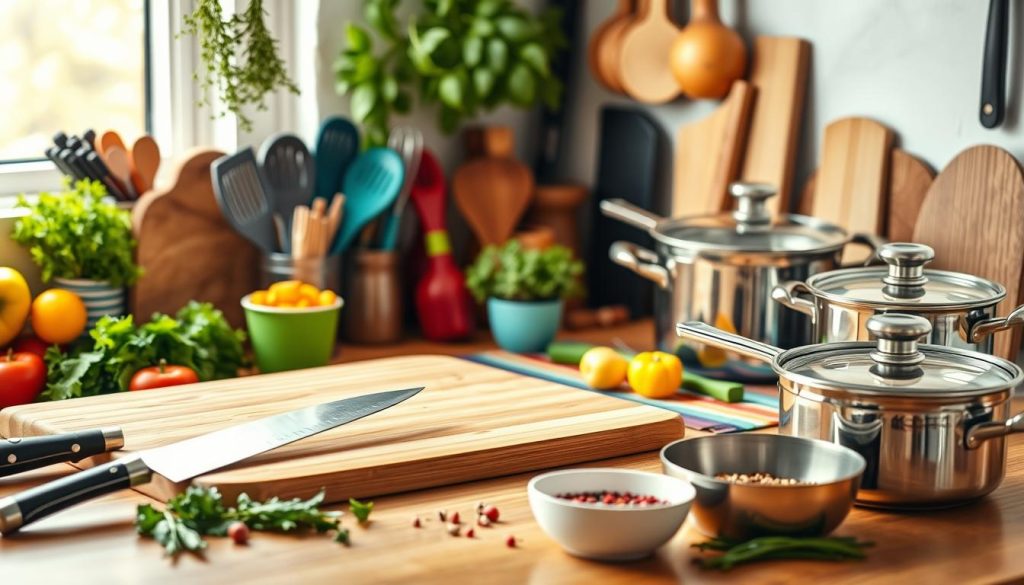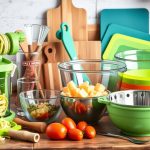Becoming a skilled chef or a confident home cook starts with the right tools. Whether you’re new to cooking or have years of experience, quality kitchen essentials are key. This guide will show you the must-have tools to elevate your cooking skills.
With these tools, you’ll be able to make delicious meals like a pro. You’ll learn to cook like a chef, even in your own kitchen.
Key Takeaways
- Equipping your kitchen with essential tools is crucial for successful cooking
- Quality kitchen equipment can make tasks easier, more efficient, and improve your culinary outcomes
- Understanding the basics of kitchen tools and their proper use is key for beginner cooks
- Investing in versatile, high-quality tools can save money in the long run
- Maintaining and properly caring for your kitchen tools will extend their lifespan
Understanding the Basics of Kitchen Equipment
Having the right tools in your kitchen is key for any home cook. It doesn’t matter if you’re just starting or have years of experience. Knowing the basics of kitchen equipment can greatly improve your cooking and the taste of your dishes.
Why Quality Tools Matter
Choosing high-quality cooking utensils and kitchen gear for home cooks is a smart investment. Good tools make cooking easier and more efficient. They also help make your dishes better. Cheap tools might break or not work well, which can be frustrating and even unsafe.
Investment vs. Cost-Cutting
Finding a balance between spending on quality cooking utensils and keeping costs down is important. While cheap options might seem appealing, it’s often better to spend a bit more. This ensures your kitchen gear for home cooks will last and work well. Look for brands that are well-reviewed and offer good value.
Safety Considerations
When choosing and using your cooking utensils and kitchen gear for home cooks, safety is crucial. Tools like sharp knives and hot surfaces can be dangerous. Make sure you know how to use them safely to enjoy cooking without worry.
“The right tools can make all the difference in the kitchen. Invest in quality cooking utensils and kitchen gear for home cooks to elevate your culinary skills and enjoy the cooking process.”
| Tool | Key Considerations | Recommended Features |
|---|---|---|
| Chef’s Knife | Sharpness, balance, and comfort | High-carbon stainless steel blade, full tang construction, ergonomic handle |
| Cutting Board | Material, size, and thickness | Durable wood or high-quality plastic, non-slip base, easy to clean |
| Saucepan | Material, heat conductivity, and size | Stainless steel or heavy-duty aluminum, even heat distribution, comfortable handle |
Essential Knives for Food Preparation
A good kitchen needs essential knives. These tools help you slice, dice, chop, and mince food easily. Knowing about different knives can make you a better cook.
The Chef’s Knife: A Versatile Workhorse
The chef’s knife is key in any kitchen. It’s great for many tasks, like mincing herbs and cutting meat. Its sharp edge and balanced weight make it perfect for chopping and dicing.
Paring Knives: Precision and Control
Paring knives are for detailed work. They’re small and sharp, perfect for peeling and trimming. They’re great for tasks like removing seeds from peppers.
Serrated Knives: Mastering Bread and Tomatoes
Serrated knives are best for soft foods. They cut through bread and tomatoes without tearing. This makes them essential for fresh bread and tomatoes.
Proper Knife Care and Maintenance
Keeping your knives sharp is important. Regular sharpening and hand-washing are key. This way, your knives will last a long time.
“A good knife is the foundation of any well-equipped kitchen.”
Must-Have Cutting Boards and Food Prep Surfaces
Equipping your kitchen with the right tools is key. Cutting boards and food prep surfaces are essential. They help with meal prep, slicing, and more. Knowing the benefits of different materials and how to care for them can improve your kitchen and cooking.
Wood vs. Plastic Cutting Boards
The debate between wood and plastic cutting boards is ongoing. Both have their own benefits:
- Wood cutting boards are known for their natural antimicrobial properties and durability.
- Plastic cutting boards are easy to clean and maintain, perfect for busy kitchens.
Proper Care and Maintenance
Proper care is crucial for your cutting boards, no matter the material. Regular cleaning, oiling (for wood), and occasional resurfacing are key. This keeps your boards in great shape.
Size and Storage Solutions
| Cutting Board Size | Recommended Use |
|---|---|
| Small (8-12 inches) | Herbs, spices, and small ingredients |
| Medium (14-18 inches) | Everyday meal prep, slicing, and dicing |
| Large (20+ inches) | Larger items, such as whole vegetables or meats |
For storage, use vertical or drawer organizers. This keeps your cutting boards organized and frees up counter space.
Understanding the pros and cons of cutting board materials, care, and storage is important. It helps you create a kitchen starter kit that meets your needs. Quality culinary tools like cutting boards can greatly improve your cooking.
Fundamental Cooking Vessels and Pans
Being a home cook means having the right must-have cookware and kitchen essentials. These tools are key for searing steaks and simmering sauces. A well-equipped kitchen starts with the right cooking vessels and pans.
Let’s look at the essential cookware every cook needs:
- Skillets: They’re versatile and durable, great for sautéing, frying, and browning. Choose ones with a sturdy base and handles that stay cool.
- Saucepans: They’re crucial for boiling pasta, simmering soups, and making sauces. Get sizes from 1-quart to 4-quart for flexibility.
- Stockpots: For big dishes like chili or bone broth, a good stockpot is essential. Go for a 6-quart to 8-quart size with strong construction.
- Baking Sheets: They’re vital for roasting veggies, baking cookies, or sheet-pan dinners. Choose heavy-duty, rimmed sheets that don’t warp.
Getting the right must-have cookware and kitchen essentials changes cooking. It makes meal prep easier and more fun. With the right tools, you’ll get better at cooking.
“The right tools can make all the difference in the kitchen. Invest in quality cookware, and you’ll be rewarded with delicious, effortless meals.”
From Beginner to Chef: Essential Kitchen Tools for Every Cook
Creating delicious meals at home needs more than just cooking skills. The right kitchen tools and equipment can greatly improve your cooking experience. Whether you’re new to cooking or have years of experience, learning about the essential cooking utensils and kitchen gear for home cooks is crucial. It helps you reach your full cooking potential.
Basic Hand Tools
Every kitchen should have basic hand tools for food preparation. These include:
- Sharp knives of various sizes for cutting, slicing, and dicing
- A sturdy spatula for flipping and serving
- A whisk for blending and incorporating ingredients
- A set of measuring cups and spoons for precise measurements
Advanced Utensils
As you get better at cooking, you might need more specialized kitchen gear for home cooks. These tools can make food preparation easier and open up new cooking techniques:
- A high-quality food processor for chopping, shredding, and puréeing
- A handheld mixer or stand mixer for whipping, kneading, and mixing dough
- A set of tongs for safely handling hot foods and plating dishes
Specialty Equipment
For the aspiring home chef, investing in specialized cooking utensils can elevate your cooking skills. Consider adding these pieces to your kitchen:
- A high-powered blender for creating smooth sauces, dips, and smoothies
- A slow cooker or Instant Pot for effortless one-pot meals
- A digital food scale for precise ingredient measurements
By gathering essential cooking utensils and kitchen gear for home cooks, you’ll be well on your way to mastering home cooking. Whether you’re a beginner or an experienced chef, the right tools open up endless possibilities for culinary exploration.
Measuring Tools and Kitchen Scales
In the world of cooking equipment basics and culinary tools, getting the measurements right is key. You need the right tools to make sure your dishes come out just right. From simple measuring cups and spoons to digital scales, these tools are crucial for perfect recipes.
Measuring Cups and Spoons
Getting the measurements right is the first step to great cooking and baking. You’ll need measuring cups in different sizes for dry ingredients like flour and sugar. And don’t forget a set of measuring spoons for spices and herbs.
Digital Kitchen Scales
If you want the most precise measurements, get a digital kitchen scale. These scales measure ingredients by weight, down to the gram or ounce. This is especially important for baking, where small changes can make a big difference.
| Measuring Tool | Advantages | Considerations |
|---|---|---|
| Measuring Cups | Versatile, user-friendly, and widely available | Potential for inconsistency due to packing and leveling techniques |
| Measuring Spoons | Precise for small ingredient amounts | Limited to specific volume measurements |
| Digital Kitchen Scales | Highly accurate, especially for baking | May require a larger investment, but the precision is worth it |
Whether you’re just starting out or you’re a seasoned chef, having the right tools is key. Invest in quality measuring devices to make sure your dishes always come out right.

Food Storage Solutions and Containers
Keeping your kitchen organized is key for any cook, new or seasoned. The right containers and systems are crucial. They help keep food fresh, your kitchen clean, and your cooking smooth.
Organization Systems
Start with a good organization system for food storage. Get a variety of airtight, stackable containers in different sizes. Use them for spices, dry goods, leftovers, and fresh produce. Labeling containers with what’s inside and when you got it helps avoid waste.
Container Types and Uses
- Glass jars: Perfect for dry goods, spices, and non-perishables.
- Plastic containers: Great for leftovers, prepped ingredients, and stacking.
- Silicone bags: Versatile for marinating, freezing, and storing various foods.
- Reusable produce bags: Keep fruits and veggies fresh and cut down on plastic.
Food Safety Guidelines
Food storage is about more than just keeping things tidy. It’s also about keeping food safe. Always separate raw and cooked foods, and keep perishables at the right temperature. Clean and sanitize your containers often to keep your kitchen healthy and clean.
“The key to a well-stocked kitchen is having the right storage solutions in place. Invest in quality containers and develop an organization system that works for your cooking needs.”
Effective food storage and following safety guidelines make your kitchen starter kit ready for any culinary adventure. It helps you go from beginner to chef.
Small Appliances Worth Your Investment
Investing in the right small appliances can change your cooking game. From food processors to stand mixers, these essentials make cooking and baking easier. They help you make dishes that taste like they came from a restaurant.
The food processor is super versatile. It can chop, slice, shred, and purée ingredients quickly. It’s great for making pesto, hummus, or shredding veggies for slaws.
A stand mixer is another must-have. It can mix dough, whip cream, and make batters for cakes and cookies. A good stand mixer can take your baking to the next level.
An immersion blender is perfect for blending soups, sauces, and smoothies. It’s small and can blend right in the pot. No need to transfer ingredients to a blender.
“The right small appliances can transform your kitchen into a culinary haven, empowering you to create masterful dishes with ease.”
Small appliances are key for great cookware and kitchen tools. They make cooking and baking easier. With these tools, you can become a better chef.

Kitchen Safety Equipment and Tools
In the kitchen, safety should always come first for home cooks. You need the right tools and equipment to prevent accidents. This makes cooking safer and more enjoyable.
Protection Gear
Protective gear is key for any serious home cook. You’ll need heat-resistant gloves, aprons, and non-slip shoes. Gloves protect your hands from hot surfaces. Aprons keep your clothes clean from spills. Non-slip shoes help you avoid slipping and falling.
First Aid Essentials
- First aid kit: Keep a first aid kit ready in your kitchen. It should have bandages, antiseptic wipes, gauze, and more for minor injuries.
- Fire extinguisher: A fire extinguisher is vital for grease fires or other emergencies in the kitchen.
- Emergency numbers: Post emergency contact numbers like the fire department and poison control in your kitchen.
Kitchen Safety Best Practices
- Keep your workspace clean and organized. This reduces tripping hazards and makes cooking safer.
- Keep knives sharp. Dull knives are more dangerous because they require more force, increasing the risk of accidents.
- Stay focused while cooking. Avoid distractions and never leave the kitchen unattended, especially with hot items.
- Ensure good ventilation. A well-ventilated kitchen prevents smoke, steam, and fumes from harming your health.
Investing in the right cooking equipment basics and following safety practices makes cooking safer and more enjoyable. Remember, prioritizing kitchen safety is crucial for a great cooking experience.
| Protection Gear | First Aid Essentials | Safety Best Practices |
|---|---|---|
|
|
|
Cleaning and Maintenance Tools
Having a well-stocked kitchen starter kit is key. It makes sure your culinary tools work well and last longer. The right tools, like cleaning brushes and polishing cloths, keep your kitchen in great shape.
It’s important to clean your culinary tools right. Get stiff-bristled brushes, sponges, and microfiber cloths. They help remove tough food bits and stop buildup. Also, oil and sharpen knives to keep them sharp and prevent rust.
Storing your kitchen starter kit properly is crucial. Use knife blocks, magnetic strips, or drawer organizers to keep things tidy. For fragile items, like glassware or ceramic, use padded storage or custom containers.


